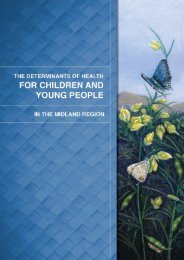Project SPLICE - Taranaki District Health Board
Project SPLICE - Taranaki District Health Board
Project SPLICE - Taranaki District Health Board
You also want an ePaper? Increase the reach of your titles
YUMPU automatically turns print PDFs into web optimized ePapers that Google loves.
<strong>Project</strong> <strong>SPLICE</strong> FINAL - February 2010<br />
2.0 Key drivers and enablers for change<br />
2.1 Introduction<br />
A total of eight days were spent by the review team in <strong>Taranaki</strong> interviewing individual<br />
stakeholders as well as multiple organisations through one-on-one interviews and focus<br />
groups as appropriate (as described in Appendix III). Key drivers and enablers have been<br />
identified on the basis of these discussions and a review against the evidence.<br />
2.2 Key Enablers<br />
The 2007 National <strong>Health</strong> Care Committee report [15] notes that there are two major foci of<br />
chronic care models. The first is proactive support for people in a community setting, which<br />
emphasises the central role of primary health care. The second looks for a redesign of the<br />
health system to deliver a continuum of care across hospital and community-based services.<br />
Both areas of change are required to successfully address issues for people with chronic<br />
conditions. <strong>Taranaki</strong> DHB is therefore seeking a way forward that is comprehensive in its<br />
approach to addressing chronic conditions. It looks to build on, and consistently implement,<br />
work under way and achieve an integrated health sector. The findings identified here clearly<br />
point to a focus on primary health care and indeed means to address health divides, as<br />
evidenced by the success against the Ministry of <strong>Health</strong> (MoH) <strong>Health</strong> Targets.<br />
2.2.1 Local strengths identified<br />
The following key local strengths were identified:<br />
Primary Care<br />
<br />
<br />
<br />
<br />
<br />
Significant nursing development activity for Practice Nurses through PHO Nurse<br />
Coordinators and Flinders Training;<br />
<strong>Project</strong> underway using an “optimising the patient journey” approach in three practices<br />
one of which involves exploring the district nursing interface;<br />
Four planned Integrated Family <strong>Health</strong> Centres as part of the Better, Sooner, More<br />
Convenient process;<br />
Most of the population is still served by well established General Practice; and<br />
Emergent long term conditions focus with an emphasis on screening, practice nurse<br />
development and some development on additional coordinated allied service delivery.<br />
Community Services<br />
<br />
Innovative examples of rural locally delivered community nursing supported by Trusts<br />
and / or local General Practice that have achieved significantly improved integration<br />
with Primary Care and enhanced the role of nursing within the practice and community.<br />
In particular this has provided some indication that a greater role could be taken by<br />
mobile nursing in support of people with long term conditions and the elderly. Likewise<br />
there is an indication that the practice nursing role can be developed to provide further<br />
clinic based activity;<br />
12 | P a g e

















